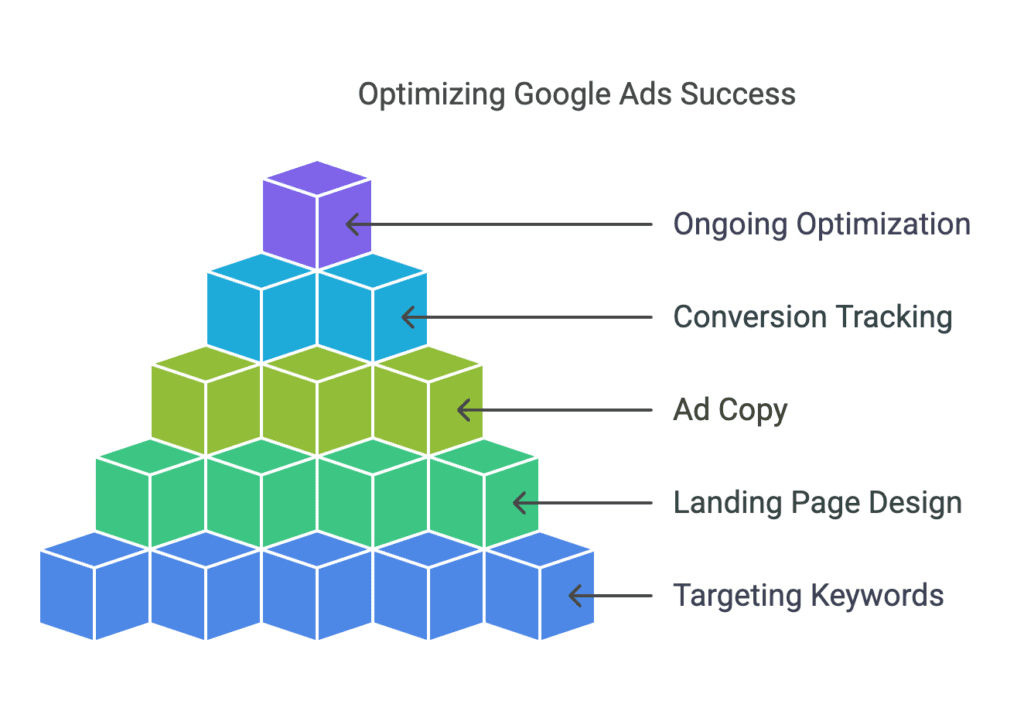Google Ads can be one of your business’s biggest growth drivers—or a giant money pit.
If you’re reading this, chances are you’ve tried running Google Ads, but the results haven’t been what you expected.
-
- You’re getting clicks, but no real leads.
-
- You’re attracting customers who aren’t the right fit.
-
- You’re spending money, but you have no idea if it’s actually working.
The truth is, Google Ads work—but only if it’s done right.
If your campaigns aren’t bringing in high-quality customers, it’s not because Google Ads is broken. It’s because something in your strategy needs to change.
Let’s break down why your ads aren’t working—and how to fix them so you start attracting the right customers in 2025.

1. You’re Targeting the Wrong Keywords
Not all Google searches are created equal.
Many business owners assume that if an ad gets clicks, it’s working. But that’s not true.
You don’t need more clicks—you need the right clicks.
Common Keyword Mistakes That Waste Your Budget:
-
- Using broad keywords – If you’re a plumber running ads for “plumber,” you’ll attract people who might be researching plumbing careers—not homeowners needing a repair.
-
- Targeting information-seekers – “How to fix a clogged drain” will bring in DIYers, not customers willing to pay for a service.
-
- Not using negative keywords – If you’re a high-end law firm, you don’t want clicks from people searching “cheap lawyer near me.”
How to Fix It:
-
- Use high-intent keywords – “24-hour emergency plumber” will attract customers who need help right now.
-
- Leverage negative keywords – Block searches that don’t align with your business (like “free consultation” if you don’t offer it).
-
- Use phrase & exact match – This prevents Google from showing your ads for irrelevant searches.
Example: A locksmith shifting from broad terms like “locksmith” to “24-hour emergency locksmith near me” saw a 3x increase in qualified leads—without increasing ad spend.
Takeaway:
Not all clicks are good clicks. A precise keyword strategy filters out bad traffic and attracts paying customers.
2. Your Landing Page Isn’t Built to Convert
If you’re sending ad traffic to your homepage, you’re burning money.
Your homepage might be well-designed, but it’s not built for conversions.
When someone clicks your ad, they’re looking for one thing: a fast, simple way to take action.
Why Your Landing Page Might Be Failing:
-
- Too many distractions – If visitors have to dig for information, they’ll leave.
-
- No clear call-to-action (CTA) – If you’re not explicitly telling them what to do next, they won’t do it.
-
- Slow load times – If your page takes more than 3 seconds to load, you’re losing 50% of visitors.
How to Fix It:
-
- Use a dedicated landing page with a clear offer and one primary CTA.
-
- Make it mobile-friendly – Over 60% of Google searches come from mobile.
-
- Highlight trust factors – Customer testimonials, reviews, and guarantees help conversions.
Example: A personal injury law firm switched from directing traffic to their homepage to using a dedicated landing page with a “Get a Free Consultation” button—and their booked calls increased by 40% overnight.
Takeaway:
A poorly optimized landing page kills your conversion rate. Your ad is only half the equation—your landing page closes the deal.
3. Your Ad Copy Isn’t Attracting the Right Customers
The wrong messaging = wasted budget.
Your ad copy determines who clicks on your ad. If your messaging is too broad or unclear, you’ll attract the wrong people.
Common Ad Copy Mistakes:
-
- Generic headlines – “Best HVAC Company” isn’t as compelling as “24/7 Emergency AC Repair – Call Now.”
-
- Misleading messaging – If your ad promises “Free Consultation” but your page says “$99 First Visit,” customers will bounce.
-
- No urgency or action-driven copy – If there’s no reason to act now, people will scroll past your ad.
How to Fix It:
-
- Be clear and specific – “$50 Off Emergency Plumbing – Call Now” works better than “Local Plumbing Services.”
-
- Match your landing page message – If your ad says “Same-Day Service,” your landing page should confirm that.
-
- Use real differentiators – Price, response time, guarantees, or customer reviews make your ad stand out.
Example: A moving company changed its ad from “Best Moving Services” to “Flat-Rate Local Moving – No Hidden Fees” and saw a 30% higher conversion rate.
Takeaway:
Your ad copy should filter out unqualified clicks while convincing the right people to take action.
4. You’re Not Tracking Conversions (So You Have No Idea What’s Working)
If you’re not tracking results, you’re flying blind.
Many businesses run ads without tracking what happens after someone clicks.
Common Tracking Mistakes:
-
- No conversion tracking – If you don’t track calls, form submissions, or purchases, you won’t know what’s working.
-
- Only tracking clicks – Clicks don’t matter if they don’t turn into leads.
-
- No call tracking – If phone calls are your primary lead source but you’re not tracking them, you have no idea which ads are generating business.
How to Fix It:
-
- Set up Google Ads conversion tracking – Measure actual leads, not just traffic.
-
- Use call tracking software – Know which ads generate the most calls.
-
- Test ad variations – Adjust your messaging and track what drives the best ROI.
Example: A law firm tracking ad conversions discovered that 70% of leads came from mobile users. By optimizing for mobile traffic, they cut wasted spend by 25%.
Takeaway:
If you’re not tracking what’s working, you’re wasting money.
5. Google Ads Is NOT a “Set It and Forget It” Strategy—Why Ongoing Optimization Matters
Your first campaign setup isn’t the final version—it’s just the starting point.
Many businesses treat Google Ads like a one-time setup—but ad performance changes over time.
Why Ongoing Optimization is Critical:
-
- Competitors adjust their strategies – If you’re not improving, you’re falling behind.
-
- Google’s AI learns from your data – The more you refine, the better your ads perform.
-
- Market conditions change – What worked last year might not work today.
Example: A plumbing company reviewed its search term data monthly and discovered a new keyword driving high-value leads. By shifting budget to this term, they increased qualified leads by 45%.
Takeaway:
Google Ads requires constant refinement to maximize profitability.



